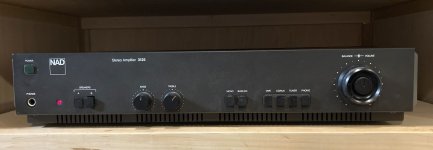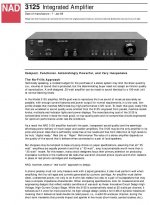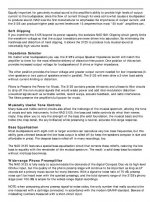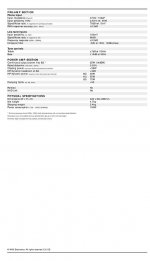Congratulations!
20 ma on output transistors is fine.
I've found in my hand built 80-90's Peavey products, experienced operators can make really good looking solder joints that pop in and out of contact depending on temperature or whether you are pressing on them. In a $2100 (1968) Hammond organ, the joints on the "main" end of the "main-aux" speaker switch weren't soldered at all. That organ cost as much as a Ford Mustang! Previous owner used "aux" speaker so she didn't notice.
Yeah, in a previous life I used to design digital test equipment & data loggers for Aeronutronic Ford. Class AB analog audio circuits are more useful to my hobbies now, despite my lack of education on them.
20 ma on output transistors is fine.
I've found in my hand built 80-90's Peavey products, experienced operators can make really good looking solder joints that pop in and out of contact depending on temperature or whether you are pressing on them. In a $2100 (1968) Hammond organ, the joints on the "main" end of the "main-aux" speaker switch weren't soldered at all. That organ cost as much as a Ford Mustang! Previous owner used "aux" speaker so she didn't notice.
Yeah, in a previous life I used to design digital test equipment & data loggers for Aeronutronic Ford. Class AB analog audio circuits are more useful to my hobbies now, despite my lack of education on them.
Last edited:
Well after going through both amp sections with a soldering iron and touching up all the solder joints the voltages around Q108 and Q109 started to look more consistent across L and R channels. So I fully connected the output power transistors Q110 and Q111. And both channels seem to be working now.
Checking solder joints (and pcb cracks) makes much of the serviceman's bread and butter.
Got it all put back together and connected to some proper speakers. Sounds GREAT! I'll have to check to see if this amp is based on the famous NAD 3020 design. Anyway, here are the updated schematics for the amplifier and power supply sections of the board. Hopefully this thread is useful to the next person who takes on rescuing one of these nice little integrated amps.
Attachments

And thanks for the extra effort you've put into documenting this. The next '3125 sufferer on here will make good use of it.
Nice looking bench, too -- I'm jealous.
Last edited:
I've got this NAD amp connected to a pair of Micca MB42 bookshelf speakers (supposedly 4 ohm) and I will say the setup can get LOUD. Speaker setting on the amp is set to 4 ohms. Don't get me wrong, it sounds fantastic. But to me the "usable" portion of the volume knob is about 15 degrees. Are these speakers just too puny for this amp? Or is this just how this particular amp is?
Depends on the source -- is it MP3 or a headphone or a DAC direct out? Some of those can be a tidy bit higher level, than typical line levels that were anticipated in 1985. 😉
Regards
Regards
I believe my turntable has a moving magnet cartridge and I am using the phono amp in the NAD. No issues when listening to records; the volume knob can be turned about 90 degrees before it's too loud for my tastes. I have a DVD/CD player on the AUX input and a MiniDisc deck on the TAPE input -- the signal levels that these things are putting out seem to be overdriving the inputs on the NAD and that's where the volume control is limited.
It usually isn't too much trouble to fit a 10 or 15dBV pad on the back panel jacks.
2 resistors per channel -- 3k3 / 6k8 for 9,7dBV attenuation; 1k8 / 8k2 for 14,9dBV.
2 resistors per channel -- 3k3 / 6k8 for 9,7dBV attenuation; 1k8 / 8k2 for 14,9dBV.
Should've mentioned -- those values are assuming an infinite load impedance, which of course is impossible. As long as it's 10k or so, or higher, the difference in attenuation won't amount to a lot.
edit: OK, I give up -- 11,5dBV for the 1st pair of values, with a 10k load; 16,1dBV for the 1k8 / 8k2.
edit: OK, I give up -- 11,5dBV for the 1st pair of values, with a 10k load; 16,1dBV for the 1k8 / 8k2.
Last edited:
The 3k3 / 6k8 divider attenuator seems to get the levels about right for the inputs from the DVD player and MD player. The high frequencies are rolling off a bit, but it may be due to my kludgy solder job and 1/4W carbon resistors. I'll keep playing around with it. Thanks for the suggestion.
If you know that your driving source is OK with it, just scale those by 10 --
330R / 680R -- that'll eliminate any capacitance factor as a treble attenuator.
No need to blame your soldering .. or carbon resistors 😉. The latter could dampen high frequencies -- but only if it were a couple orders of magnitude higher frequency!
Glad it helped.

330R / 680R -- that'll eliminate any capacitance factor as a treble attenuator.
No need to blame your soldering .. or carbon resistors 😉. The latter could dampen high frequencies -- but only if it were a couple orders of magnitude higher frequency!
Glad it helped.

Last edited:
The line in attenuators worked OK but something about the volume sensitivity still wasn't sitting well with me on this amp. I got out the trusty soldering iron and touched up all the solder joints on the preamp, tone controls, volume pot board, and cleaned all the pots with a contact cleaner. That seems to have helped. Before this work the usable volume range was from 7:00 (no sound) to 7:30 (LOUD!) on the volume knob. Now it much smoother and I can turn it up to 9:00 or 10:00. It's pretty amazing that a 35 year old amp sounds this good.
Last edited:
- Home
- Amplifiers
- Solid State
- NAD 3125 blown fuses and output transistors



